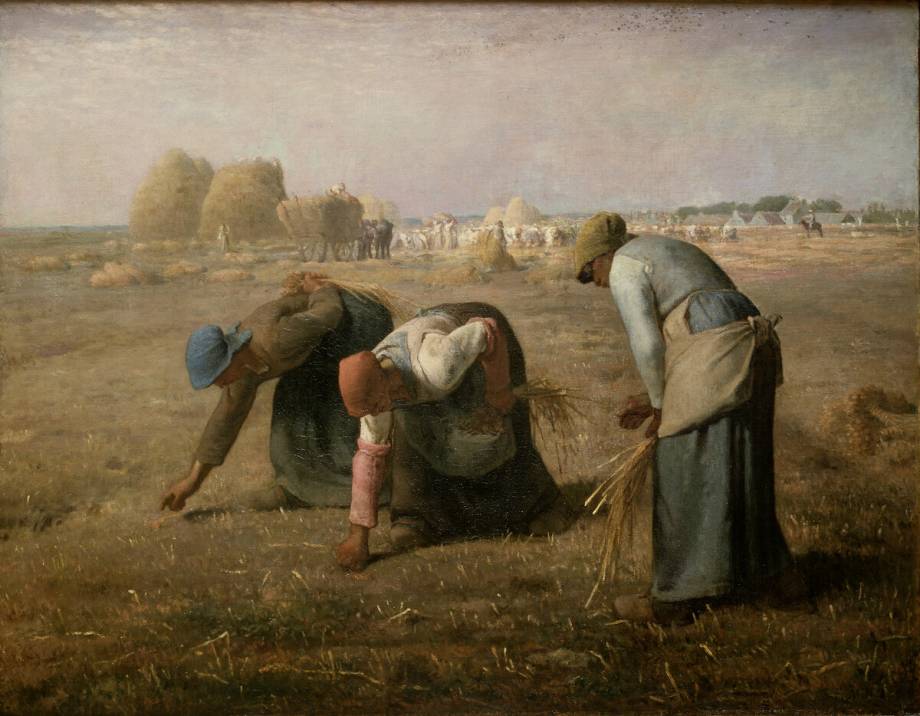Shop art print and framed art Des glaneuses by Jean-François Millet
Customise
Your art print
Des glaneuses OF Jean-François Millet
-20%Des glaneuses
Historical context and controversy surrounding Les Glaneuses
The painting Les Glaneuses, by the French painter Jean-François Millet in 1857, is undoubtedly one of the most emblematic works of peasant life and oil painting of the 19th century.
Painted in a social context marked by the Industrial Revolution and the upheavals it caused in rural life, Les Glaneuses presents a rather bleak and realistic vision of the daily lives of farm workers. This approach contrasts with the idealised, pastoral representations of the countryside that had hitherto prevailed in the art of the eighteenth and early nineteenth centuries.
When it was first presented at the Salon de Paris in 1857, the work caused a veritable scandal and divided the critics. Some saw it as a denunciation of social misery and a political stand in favour of the working classes, while others saw the painting as an apology for idleness and idleness. Whatever the case, the Gleaners remain today a powerful symbol of peasant life and the changing rural world.
Detailed description of the work
Les Glaneuses is an oil painting on canvas measuring 83.5 x 111 cm. It depicts three women bent over at work in a wheat field, under a sky veiled by clouds. In the background are haystacks and the blurred silhouettes of other workers harvesting the golden ears.
The main characters
At the heart of the composition, the three gleaners are dressed in simple, worn and dusty work clothes. Their sunburnt faces and callused hands bear witness to the harshness of their condition. The three women appear to be busy painstakingly picking up the ears of wheat scattered on the ground after the harvesters have passed.
The surrounding landscape
The choice to depict a wheat field allows Millet to highlight the close relationship between the peasants and the nourishing earth. The colour palette used for the sky, a stormy grey, contrasts with the warm, golden hues of the wheat in the foreground. This chromatic opposition reinforces the dramatic atmosphere of the scene. All the elements of the composition work together to make us feel the sense of fatigue and weariness emanating from the characters.
Millet's style: realism and humanism
The Gleaners is an emblematic painting of realism, an artistic movement that emerged in France in the second half of the 19th century. Realist painters, such as Jean-François Millet, Gustave Courbet and Rosa Bonheur, sought to depict the world without idealisation or embellishment. They favoured subjects drawn from everyday life and highlighted the working and living conditions of the working classes.
In this work, the artist adopts a resolutely humanistic and empathetic approach to his characters. He manages to convey their dignity and courage in the face of adversity, while implicitly denouncing social injustice and the precariousness of their existence. This artistic bias gives Les Glaneuses a universal and timeless dimension.
Influence and posterity of the work
Over the decades, Les Glaneuses has inspired numerous artists and authors, who have taken up, diverted or adapted the theme and iconography of Millet's painting. Among the most famous tributes are:
- The documentary film "Les glaneurs et la glaneuse" directed by Agnès Varda in 2000, which explores the phenomenon of gleaning in all its forms and questions our relationship with consumption and waste;
- The series of photographs entitled "Haystacks : Homage to Millet" by contemporary artist Vik Muniz, which uses unusual materials (dust, chocolate, confetti...) to recreate scenes inspired by the works of Millet;
- The novel "Des bleus à l'âme" by Françoise Sagan, whose heroine is a young woman with a passion for art who becomes irresistibly fascinated by the Glaneuses.
This artwork is a painting from the classical period. It belongs to the barbizon school styles and realism styles.
« Des glaneuses » is kept at Musee d'Orsay, Paris, France.
Find the full description of Des glaneuses by Jean-François Millet on Wikipedia.



































